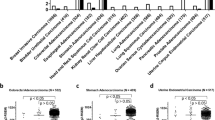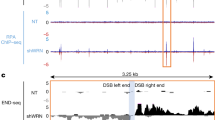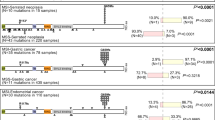Abstract
The activin type II receptor (ACVR2) contains two identical microsatellites in exons 3 and 10, but only the exon 10 microsatellite is frameshifted in mismatch repair (MMR)-defective colonic tumors. The reason for this selectivity is not known. We hypothesized that ACVR2 frameshifts were influenced by DNA sequences surrounding the microsatellite. We constructed plasmids in which exons 3 or 10 of ACVR2 were cloned +1 bp out of frame of enhanced green fluorescent protein (EGFP), allowing –1 bp frameshift to express EGFP. Plasmids were stably transfected into MMR-deficient cells, and subsequent non-fluorescent cells were sorted, cultured and harvested for mutation analysis. We swapped DNA sequences flanking the exon 3 and 10 microsatellites to test our hypothesis. Native ACVR2 exon 3 and 10 microsatellites underwent heteroduplex formation (A7/T8) in hMLH1−/− cells, but only exon 10 microsatellites fully mutated (A7/T7) in both hMLH1−/− and hMSH6−/− backgrounds, showing selectivity for exon 10 frameshifts and inability of exon 3 heteroduplexes to fully mutate. Substituting nucleotides flanking the exon 3 microsatellite for nucleotides flanking the exon 10 microsatellite significantly reduced heteroduplex and full mutation in hMLH1−/− cells. When the exon 3 microsatellite was flanked by nucleotides normally surrounding the exon 10 microsatellite, fully mutant exon 3 frameshifts appeared. Mutation selectivity for ACVR2 lies partly with flanking nucleotides surrounding each microsatellite.
This is a preview of subscription content, access via your institution
Access options
Subscribe to this journal
Receive 50 print issues and online access
$259.00 per year
only $5.18 per issue
Buy this article
- Purchase on Springer Link
- Instant access to full article PDF
Prices may be subject to local taxes which are calculated during checkout





Similar content being viewed by others
Abbreviations
- TGFBR2:
-
transforming growth factor β receptor 2
- ACVR2:
-
activin type II receptor
- MMR:
-
mismatch repair system
- MSI:
-
microsatellite instability
- IDL:
-
insertion deletion loop
- MR:
-
mutation resistant
- IF:
-
in frame of EGFP
- OF:
-
out of frame of EGFP
- EGFP:
-
enhanced green fluorescent protein
- CRC:
-
colorectal cancer
References
Acharya S, Wilson T, Gradia S, Kane MF, Guerrette S, Marsischky GT et al. (1996). hMSH2 forms specific mispair-binding complexes with hMSH3 and hMSH6. Proc Natl Acad Sci USA 93: 13629–13634.
Akiyama Y, Sato H, Yamada T, Nagasaki H, Tsuchiya A, Abe R et al. (1997). Germ-line mutation of the hMSH6/GTBP gene in an atypical hereditary nonpolyposis colorectal cancer kindred. Cancer Res 57: 3920–3923.
Carethers JM, Chauhan DP, Fink D, Nebel S, Bresalier RS, Howell SB et al. (1999). Mismatch repair proficiency and in vitro response to 5-fluorouracil. Gastroenterology 117: 123–131.
Chung H, Young DJ, Lopez CG, Le TA, Lee JK, Ream-Robinson D et al. (2008). Mutation rates of TGFBR2 and ACVR2 coding microsatellites in human cells with defective DNA mismatch repair. PLoS ONE 3: e3463.
Fishel R, Lescoe MK, Rao MR, Copeland NG, Jenkins NA, Garber J et al. (1993). The human mutator gene homolog MSH2 and its association with hereditary nonpolyposis colon cancer. Cell 75: 1027–1038.
Grady WM, Carethers JM . (2008). Genomic and epigenetic instability in colorectal cancer pathogenesis. Gastroenterology 135: 1079–1099.
Harrington JM, Kolodner RD . (2007). Saccharomyces cerevisiae Msh2-Msh3 acts in repair of base-base mispairs. Mol Cell Biol 27: 6546–6554.
Hempen PM, Zhang L, Bansal RK, Iacobuzio-Donahue CA, Murphy KM, Maitra A et al. (2003). Evidence of selection for clones having genetic inactivation of the activin A type II receptor (ACVR2) gene in gastrointestinal cancers. Cancer Res 63: 994–999.
Herman JG, Umar A, Polyak K, Graff JR, Ahuja N, Issa JP et al. (1998). Incidence and functional consequences of hMLH1 promoter hypermethylation in colorectal carcinoma. Proc Natl Acad Sci USA 95: 6870–6875.
Jung B, Doctolero RT, Tajima A, Nguyen AK, Keku T, Sandler RS et al. (2004). Loss of activin receptor type 2 protein expression in microsatellite unstable colon cancers. Gastroenterology 126: 654–659.
Jung B, Smith EJ, Doctolero RT, Gervaz P, Alonso JC, Miyai K et al. (2006). Influence of target gene mutations on survival, stage and histology in sporadic microsatellite unstable colon cancers. Int J Cancer 118: 2509–2513.
Jung BH, Beck SE, Cabral J, Chau E, Cabrera BL, Fiorino A et al. (2007). Activin type 2 receptor restoration in MSI-H colon cancer suppresses growth and enhances migration with activin. Gastroenterology 132: 633–644.
Luria SE, Delbruck M . (1943). Mutations of bacteria from virus sensitivity to virus resistance. Genetics 28: 491–511.
Markowitz S, Wang J, Myeroff L, Parsons R, Sun L, Lutterbaugh J et al. (1995). Inactivation of the type II TGF-beta receptor in colon cancer cells with microsatellite instability. Science 268: 1336–1338.
Marsischky GT, Kolodner RD . (1999). Biochemical characterization of the interaction between the Saccharomyces cerevisiae MSH2-MSH6 complex and mispaired bases in DNA. J Biol Chem 274: 26668–26682.
Modrich P . (2006). Mechanisms in eukaryotic mismatch repair. J Biol Chem 281: 30305–30309.
Nicolaides NC, Papadopoulos N, Liu B, Wei YF, Carter KC, Ruben SM et al. (1994). Mutations of two PMS homologues in hereditary nonpolyposis colon cancer. Nature 371: 75–80.
Palombo F, Iaccarino I, Nakajima E, Ikejima M, Shimada T, Jiricny J . (1996). hMutSbeta, a heterodimer of hMSH2 and hMSH3, binds to insertion/deletion loops in DNA. Curr Biol 6: 1181–1184.
Papadopoulos N, Nicolaides NC, Wei YF, Ruben SM, Carter KC, Rosen CA et al. (1994). Mutation of a mutL homolog in hereditary colon cancer. Science 263: 1625–1629.
Parsons R, Myeroff LL, Liu B, Willson JK, Markowitz SD, Kinzler KW et al. (1995). Microsatellite instability and mutations of the transforming growth factor beta type II receptor gene in colorectal cancer. Cancer Res 55: 5548–5550.
Thibodeau SN, Bren G, Schaid D . (1993). Microsatellite instability in cancer of the proximal colon. Science 260: 816–819.
Veigl ML, Kasturi L, Olechnowicz J, Ma AH, Lutterbaugh JD, Periyasamy S et al. (1998). Biallelic inactivation of hMLH1 by epigenetic gene silencing, a novel mechanism causing human MSI cancers. Proc Natl Acad Sci USA 95: 8698–8702.
Woerner SM, Kloor M, Mueller A, Rueschoff J, Friedrichs N, Buettner R et al. (2005). Microsatellite instability of selective target genes in HNPCC-associated colon adenomas. Oncogene 24: 2525–2535.
Acknowledgements
This study was supported by the United States Public Health Service (DK067287 to JMC), the UCSD Digestive Diseases Research Development Center (DK080506), and the VA Research Service (Merit Review Award to JMC). We thank the support of Moores UCSD Cancer Center Flow Cytometry and DNA Sequencing Shared Resources.
Author contributions: Chung H and Carethers JM designed the research; Chung H, Young DJ, Lopez CG, Lai J, Holmstrom J, Cabrera BL and Ream-Robinson D performed the research; Chung H, Lopez CG and Carethers JM analyzed data; and Chung H and Carethers JM wrote the paper. All authors have approved the final version of this paper.
Author information
Authors and Affiliations
Corresponding author
Ethics declarations
Competing interests
The authors declare no conflict of interest.
Additional information
Supplementary Information accompanies the paper on the Oncogene website
Rights and permissions
About this article
Cite this article
Chung, H., Lopez, C., Young, D. et al. Flanking sequence specificity determines coding microsatellite heteroduplex and mutation rates with defective DNA mismatch repair (MMR). Oncogene 29, 2172–2180 (2010). https://doi.org/10.1038/onc.2009.508
Received:
Revised:
Accepted:
Published:
Issue Date:
DOI: https://doi.org/10.1038/onc.2009.508
Keywords
This article is cited by
-
A new method for discovering EMAST sequences in animal models of cancer
Scientific Reports (2018)
-
Microsatellite Instability Pathway and EMAST in Colorectal Cancer
Current Colorectal Cancer Reports (2017)
-
GRG Profiles: John M. Carethers
Digestive Diseases and Sciences (2016)
-
Microsatellite instability in colorectal cancer: from molecular oncogenic mechanisms to clinical implications
Cellular Oncology (2011)



